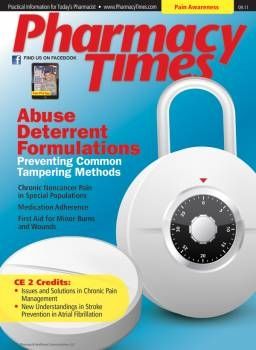Publication
Article
Pharmacy Times
The Effects of New FDA APAP Regulations on Pharmacy Practice
Author(s):
Changes in the strength and labeling of OTC and prescription products containing acetaminophen present counseling opportunities for pharmacists.
Acetaminophen, also known as APAP, is an analgesic commonly used for relief of pain and fever in both Rx and OTC medications. An active ingredient in more than 600 medicines,1 it can be combined in prescription pain relievers with opioids such as codeine, oxycodone, and hydrocodone. APAP is generally considered safe and effective when used as directed.

Why Reduce APAP in Prescription Combination Drugs?
Although acetaminophen is widely used for managing pain, studies have shown that excess consumption can seriously impair liver function. According to the FDA’s Office of New Drugs “overdose from prescription combination products containing acetaminophen accounts for nearly half of all cases of acetaminophen-related liver failure in the United States, many of which result in liver transplant or death.” Most cases of severe liver injury occur when patients take multiple APAP-containing products at the same time, exceed the current recommended maximum dose of 4000 mg (4 g) within a 24-hour period, and/or consume alcohol while taking acetaminophen medications.2
To mitigate concerns about the link between acetaminophen overdose and liver failure, in January 2011 the FDA asked manufacturers of prescription combination medicines containing APAP to limit the amount to a maximum of 325 mg per tablet, capsule, or other dosage unit in an effort to reduce the incidence of liver failure associated with high doses. The FDA believes that prescription combination drugs containing no more than 325 mg of acetaminophen per unit dose are effective for treating pain. Higher-dose prescription combination APAP products will gradually be phased out over the next 3 years. The new guidelines do not affect OTC medications.3
Drug industry organizations are also evaluating lowering the recommended maximum daily dose of acetaminophen to 3000 mg. Pharmaceutical manufacturers such as Johnson & Johnson’s McNeil Consumer Healthcare are already reducing the recommended maximum daily dosage of some APAP-containing medications to 3000 mg.4 The new APAP regulations will introduce major changes for drug manufacturers, prescribing physicians, pharmacists, as well as patients.
Education on Product Labeling is Key
Pharmacists have an important role in helping their patients use acetaminophen-containing prescription medicines safely and educating them on product labeling.
A recognized labeling issue is that many patients don’t understand that the designation “APAP” is, in fact, acetaminophen. Patients can accidentally overdose on the drug when they ingest more than 1 product that contains acetaminophen at the same time—a serious possibility if they are unaware that APAP is another name for the same ingredient. This lack of knowledge contributes to unintentional acetaminophen overdosage.5
In July 2011, the National Council for Prescription Drug Programs recommended that drug producers and pharmacies should consistently spell out acetaminophen on their product labels to avoid patient confusion.6 Vendors supplying pharmacy software systems and labeling data should consider doing so as well to ensure the full name “acetaminophen” appears on patient labels and printouts rather than the APAP abbreviation.
Many patients may need counseling to understand new prescription combination APAP product labeling that underscores the risk of liver toxicity and allergic reactions. The January 2011 FDA drug safety communication reducing the maximum allowable APAP strength also requires pharmaceutical manufacturers to update the labels of all prescription combination APAP drugs to clearly warn consumers of possible liver damage from overdose. The FDA now mandates that a boxed warning—the agency’s strongest warning for prescription drugs—be added to the label of all prescription products containing acetaminophen to highlight the potential risk for severe liver injury. The agency also requires a warning on product labels to call attention to possible severe allergic reactions including swelling of the face, mouth, and throat (anaphylaxis), difficulty breathing, itching, and rash.3
It is critical for pharmacists to discuss the new label changes with patients taking APAP medications, both prescription and OTC, and to point out these risks explicitly. They should educate patients about the other products in which acetaminophen is commonly found and its other names or abbreviations.
Implications for Pharmacy Practice
Pharmacies could be affected both positively and negatively by the APAP regulation change. Although the FDA has stated that the elimination of higher-dose prescription combination acetaminophen products should not create a shortage of pain medication,7 drug makers are expected to reduce their prescription combination APAP offerings simply by limiting production to only the lower-strength options. Fewer SKUs in this category will make inventory management easier and will free up shelf space. The change may even decrease dispensing errors, because there will be fewer strengths from which to choose.
But there are several possible downsides to the new FDA APAP rules. Frequently expressed concerns include patient abuse of OTC acetaminophen medicines; increased use and abuse of single-agent narcotics; 5 higher demand for those controlled substances and with it a need for greater security; and an uptick in counterfeiting or non-US sourcing. Pharmacists can also anticipate providing additional counseling to help patients navigate changes to their pain management regimens as physicians switch to the lower dose options or different molecules altogether.
Even with the current availability of higher-dose prescription combination acetaminophen products, patients taking these medicines are often not managing their doses correctly. As APAP combination products transition from higher strengths to 325 mg, a patient may decide to take more of these lower-dose combination drugs for pain control than prescribed, increasing chances for addiction to the opioid component. Those suffering acute pain could also potentially abuse OTC APAP medicines for supplemental pain relief. Thus, pharmacists also need to ask their customers about the OTC products they are using, monitor both prescription and OTC APAP intake,5 as well as help patients calculate the total amount of acetaminophen they are consuming from all sources.
With the transition to lower-dose prescription combination acetaminophen products, patients will need new medication regimens, especially for those dealing with chronic pain. Prescribers, hospitals, and other health care providers who write scripts or administer APAP-containing prescription drugs must develop new pain management guidelines.
Some physicians may recommend single-use drugs combined with OTC medicines to control pain. If doctors prescribe more opioid agents to compensate for decreased acetaminophen content in prescription combination drugs, frequent use may lead to patient abuse and addiction to single-agent narcotics. Greater demand for these Class II controlled substances will increase pharmacy stocking requirements and may call for extra security precautions.
If more prescriptions are written for single-ingredient pain relievers, pharmacists’ workloads could increase with the need for in-depth patient counseling on safe and effective use of these narcotics. Also, Class II products require hard-copy scripts and cannot be refilled.5 This would prompt patients to visit their doctors more often to ensure a continued supply. For the dispensing pharmacy, more new scripts mean more data entry and processing time.
Finally, counterfeiting of prescription combination APAP medications and sourcing outside the United States, especially online ordering, could rise along with the increased demand from chronic pain sufferers. Some patients may simply refuse to change from drugs they’ve found effective in the past. Because legitimate outlets will be closed to them, some may seek these substances online, over the border or through other unregulated sources. Pharmacists should be proactive in speaking with patients who are currently taking the targeted combination-APAP products and warn against such actions.
Conclusions
The FDA’s January 2011 ruling lowering the amount of acetaminophen in prescription combination medicines will bring about material changes for pharmaceutical suppliers, prescribing physicians, pharmacists, and patients. Pharmacists and other health care professionals can use the following talking points to educate patients about the proper use of acetaminophen3:
- Early this year, the FDA passed new regulations to protect consumers from potential liver damage and allergic reactions caused by an overdose of acetaminophen. As a result, drug manufacturers will gradually reduce the amount of acetaminophen in prescription combination medicines to a maximum of 325 mg per tablet, capsule, or other unit dose.
- Be aware that “APAP” is another name for acetaminophen; they are the same ingredient.
- Do not take more than the prescribed dose of an acetaminophen-containing medication.
- Do not take more than 1 product that contains acetaminophen at the same time.
- Do not drink alcohol while taking acetaminophen-containing products.
- Read all prescription and OTC labels to ensure that you are not accidentally taking multiple acetaminophen-containing products in pain relievers, cough and cold products, and sinus medicines. Look for both acetaminophen and APAP in the list of ingredients. Examples of APAP-containing OTC medications include Tylenol, NyQuil, Vicks, and Coricidin.
- Seek medical help immediately if you believe you have taken more acetaminophen than directed or experience swelling of the face, mouth, and throat, difficulty breathing, itching, or rash after taking acetaminophen. Report adverse events to the FDA’s MedWatch program at www.fda.gov/Safety/MedWatch.8
Pharmacists need to prepare for a gradual reduction in prescription combination APAP products by reassessing their shelf inventory and automated dispensing units. They will need to address security issues to protect their stocks of Class II controlled substances. But most importantly, pharmacy practice professionals will need to spend more time educating patients and exercising vigilance in monitoring their overall pain management programs to ensure the continued safe use of acetaminophen-containing medications.
Jiten Parikh, RPh, is vice president operations at Amneal Pharmaceuticals in Branchburg, New Jersey, and is a cofounder of the company. In addition to a decade of experience in the generics industry, he has more than 15 years of management experience in retail pharmacy with Eckerd (later RiteAid) as well as health system and mail order pharmacy organizations. Mr. Parikh holds a BS in pharmacy from Rutgers University.
Kammi Wilson is marketing manager at Amneal Pharmaceuticals in Newport Beach, California. Prior to joining Amneal, Ms. Wilson was director of marketing at AmerisourceBergen for the acute care and retail markets. Ms. Wilson holds a BA from UCLA and an MA from the Annenberg School for Communication & Journalism at the University of Southern California.
References
1. A guide to safe use of pain medicine. US FDA Web Site. www.fda.gov/ForConsumers/ConsumerUpdates/ucm095673.htm. Accessed July 14, 2011.
2. New steps aimed at cutting risks from acetaminophen. US FDA Web site. www.fda.gov/ForConsumers/ConsumerUpdates/ucm239747.htm. Accessed July 25, 2011.
3. FDA drug safety communication: prescription acetaminophen products to be limited to 325 mg per dosage unit; boxed warning will highlight potential for severe liver failure. US FDA Web site. www.fda.gov/Drugs/DrugSafety/ucm239821.htm. Accessed July 27, 2011.
4. Tylenol maker to change dosage guidelines. United Press International Web site. www.upi.com/Health_News/2011/07/29/Tylenol-maker-to-change-dosage-guidelines/UPI-96131311967664. Accessed August 11, 2011.
5. Changing winds: practice implications of acetaminophen regulations. ORTHOSuperSite Web site. www.orthosupersite.com/view.aspx?rid=44033. Accessed August 4, 2011.
6. NCPDP recommendations for improved prescription container labels for medicines containing acetaminophen. US FDA Web site. www.fda.gov/downloads/Drugs/DrugSafety/UCM266631.pdf. Accessed August 8, 2011.
7. List of marketed acetaminophen-containing prescription products. US FDA Web site. www.fda.gov/Drugs/DrugSafety/InformationbyDrugClass/ucm239874.htm. Accessed July 15, 2011.
8. Questions and answers about oral prescription acetaminophen products to be limited to 325 mg per dosage unit. US FDA Web site. www.fda.gov/Drugs/DrugSafety/InformationbyDrugClass/ucm239871.htm. Accessed July 15, 2011.
9. FDA MedWatch. US FDA Web site. www.fda.gov/Safety/MedWatch.







